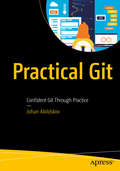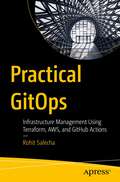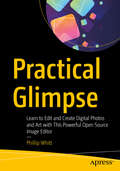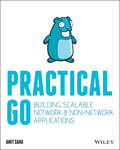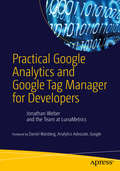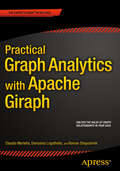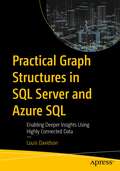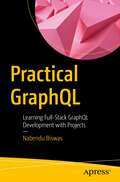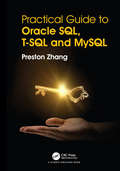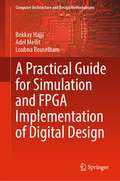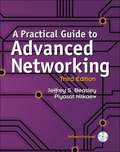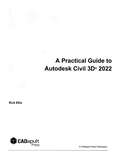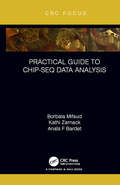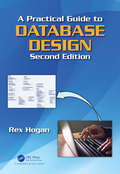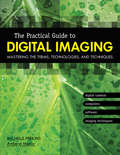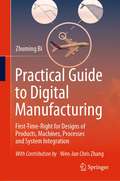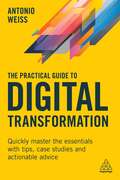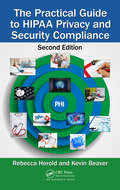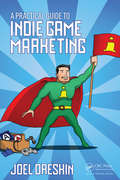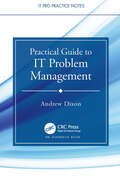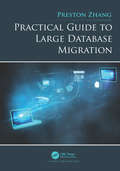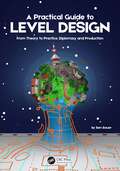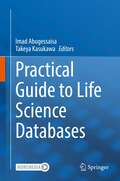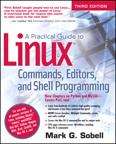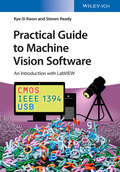- Table View
- List View
Practical Git: Confident Git Through Practice
by Johan AbildskovPractice your Git skills using exercises in your own environment. This book introduces concepts in an abstract visual way, and then enforces this learning through exercises - the Git katas. You will start with basic interactions such as commits and branches, and move on to both internals and collaborative workflows. Best practices are introduced and rehearsed throughout with hands-on exercises. Each topic is supplemented with interactive Git exercises that can be solved using any Git client – either the ubiquituous CLI or one of the many graphical clients so you'll learn in the environment you work in. The importance of Git is hard to overstate – it is used by 90% of software engineers worldwide and is the de facto standard for version control. Honing your Git skills is guaranteed to make you a better and more efficient developer. Building software can be stressful, but it doesn’t need to be. Practical Git will give you the Git skills you need, and help keep your Git skills sharp. Add it to your library today. What You'll LearnUse Git through scripted exercises and the Git katas Understand Git’s graph modelTroubleshoot common and rare scenarios you may faceSelect and apply the right Git tool for the taskMaintain and collaborate on Git repositoriesTweak Git to gain the most from this powerful tool Who This Book Is For Anyone who is currently using Git in a copy-paste fashion. It will take you from using Git to knowing Git.
Practical GitOps: Infrastructure Management Using Terraform, AWS, and GitHub Actions
by Rohit SalechaInfrastructure as Code (IaC) is gaining popularity and developers today are deploying their application environments through IaC tools to the cloud. However, it can become extremely difficult and time-consuming to manage the state of the infrastructure that has been deployed. This book will provide a complete walkthrough of deploying a SpringBoot application on AWS with multiple environments like production, staging and development. Everything is orchestrated through GitHub Actions and executed through Terraform Cloud to monitor changes in your infrastructure and manage its state. You'll start by reviewing how your infrastructure can be stored in code by spinning up an EC2 server first through the console, then AWS CLI and then using Terraform. You'll then be presented with a practical scenario of setting up a simple EC2 server in a multi-environment (production, staging and development) using GitHub Actions and Terraform Cloud. In the advanced section that follows, this simple EC2 server is expanded into an application that is deployed on an AWS EKS (Elastic Kubernetes Service) using AWS RDS (Relational Database Service) exposed through an AWS ALB (Application Load Balancer) protected using AWS ACM (AWS Certificate Manager), and accessible by setting the AWS Route53. The book then builds up on this infrastructure and demonstrates how it can be deployed in a multi-environment scenario by implementing accounts through AWS organizations. You'll see how to put in restrictions through Service Control Policies, how to protect secrets using AWS Secrets Manager, and how to work with least privileges using IRSA (IAM Roles for Service Accounts). Finally, you'll make the infrastructure more observable using Graphana, Prometheus, and AWS OpenSearch, run security tools, host Route53 zones dynamically based on environments, and implement CloudWatch Alarms for various use cases.
Practical Glimpse: Learn to Edit and Create Digital Photos and Art with This Powerful Open Source Image Editor
by Phillip WhittLearn how to edit images and create compelling digital art with Glimpse, the newest open source alternative to Adobe Photoshop and GIMP. This book explores Glimpse's broad selection of tools and features that can create beautiful (raster) digital art; painting, drawings, and art created from photos by applying one of the many filters to create artistic effects. You will quickly become acquainted with this powerful program and understand how to use workspace tools and layers. You will learn step-by-step how to correct exposure, digitally retouch and repair damaged photos, and handle just about any photo editing task—even colorizing grayscale images. Practice files are provided with step-by-step instructions to jump into photo editing and art creation. Glimpse is a powerful program that is a viable alternative to Adobe Photoshop and other proprietary software. The possibilities of the art one can create are almost limitless—get started with it using this book today.What You'll LearnNavigate the Glimpse workspaceUse layers, which are essential in any professional quality image editing programWork with the varied tools that Glimpse offersEnhance, retouch, and modify digital imagesRestore and repair damaged family photos, and create composites such as replacing backgroundsCreate compelling digital artwork using the drawing tools and by applying artistic filtersWho This Book Is For Anyone desiring to learn serious image editing with Glimpse. It can be used by both fledgling and professional photographers, freelance graphic designers, students, genealogists, and more. Because it’s free, it can be especially advantageous to teachers, students, and small business owners on a budget.
Practical Go: Building Scalable Network and Non-Network Applications
by Amit SahaStep-by-step instruction on writing your first production-ready servers with Golang Google's Go language, otherwise known as Golang, is a fast, simple, and reliable language that is rapidly becoming a highly popular choice for developers of all kinds. With particular utility in cloud-native environments, Golang is being adopted in major projects like Docker and Ethereum thanks to its user-friendly features, like concurrency and easy deployment. In Practical Golang: Building Scalable Network and Non-Network Applications, expert coder and devops engineer Amit Saha delivers a step-by-step guide to writing production-ready HTTP 1.1, HTTP2, RPC, and TCP/UDP servers. Walking you through the entire process of learning this already straightforward language, from your first application to your first deployed server, the authors rely solely on the most popular open-source projects to ensure you can apply the book's advice in any cloud environment. In this book, you'll get: Fulsome descriptions of best practices on load balancing, scaling, and failure handling Stepwise guidance on writing an HTTP service from scratch using only Golang's standard library Easy tutorials on implementing RPC and HTTP interfaces for RPC services Straightforward instructions on using SQL databases Perfect for software developers, devops engineers, and other programming professionals, Practical Golang is also an indispensable resource for anyone who wants to go beyond the basics of Golang and deploy robust and practical servers.
Practical Google Analytics and Google Tag Manager for Developers
by Jonathan WeberWhether you're a marketer with development skills or a full-on web developer/analyst, Practical Google Analytics and Google Tag Manager for Developers shows you how to implement Google Analytics using Google Tag Manager to jumpstart your web analytics measurement. There's a reason that so many organizations use Google Analytics. Effective collection of data with Google Analytics can reduce customer acquisition costs, provide priceless feedback on new product initiatives, and offer insights that will grow a customer or client base. So where does Google Tag Manager fit in? Google Tag Manager allows for unprecedented collaboration between marketing and technical teams, lightning fast updates to your site, and standardization of the most common tags for on-site tracking and marketing efforts. To achieve the rich data you're really after to better serve your users' needs, you'll need the tools Google Tag Manager provides for a best-in-class implementation of Google Analytics measurement on your site. Written by data evangelist and Google Analytics expert Jonathan Weber and the team at LunaMetrics, this book offers foundational knowledge, a collection of practical Google Tag Manager recipes, well-tested best practices, and troubleshooting tips to get your implementation in tip-top condition. It covers topics including: * Google Analytics implementation via Google Tag Manager * How to customize Google Analytics for your unique situation * Using Google Tag Manager to track and analyze interactions across multiple devices and touch points * How to extract data from Google Analytics and use Google BigQuery to analyze Big Data questions What you'll learn Implementation approaches for Google Analytics, including common pitfalls and troubleshooting strategies. How to use tools like Google Tag Manager and jQuery to jumpstart your Google Analytics implementation. How to track metrics beyond page views to other critical user interactions, such as clicks on outbound links or downloads, scrolling and page engagement, usage of AJAX forms, and much more. How to incorporate additional, customized data into Google Analytics to track individual users or enrich data about their behavior. Who this book is for Web developers, data analysts, and marketers with a basic familiarity with Google Analytics from an end-user perspective, as well as some knowledge of HTML and JavaScript. Table of Contents Google Analytics Fundamentals Basic Google Analytics Measurement Introducing Google Tag Manager (GTM) Testing Your Implementation Tracking Interactions using Google Tag Manager Goals: Measuring Conversions Ecommerce: Tracking Products and Purchases Cleaning Up and Enriching Data Measuring Campaigns and Troubleshooting Traffic Sources Tracking Users Across Devices Providing Additional Data about your Users GA's Measurement Protocol: Collecting data from anywhere Collecting Data from Mobile Apps with GA & GTM Importing Data into GA Using GA with BigQuery for Big Data analysis Appendix: Google Tag Manager and Google APIs
Practical Graph Analytics with Apache Giraph
by Claudio Martella Roman Shaposhnik Dionysios LogothetisPractical Graph Analytics with Apache Giraph helps you build data mining and machine learning applications using the Apache Foundation's Giraph framework for graph processing. This is the same framework as used by Facebook, Google, and other social media analytics operations to derive business value from vast amounts of interconnected data points. Graphs arise in a wealth of data scenarios and describe the connections that are naturally formed in both digital and real worlds. Examples of such connections abound in online social networks such as Facebook and Twitter, among users who rate movies from services like Netflix and Amazon Prime, and are useful even in the context of biological networks for scientific research. Whether in the context of business or science, viewing data as connected adds value by increasing the amount of information available to be drawn from that data and put to use in generating new revenue or scientific opportunities. Apache Giraph offers a simple yet flexible programming model targeted to graph algorithms and designed to scale easily to accommodate massive amounts of data. Originally developed at Yahoo!, Giraph is now a top top-level project at the Apache Foundation, and it enlists contributors from companies such as Facebook, LinkedIn, and Twitter. Practical Graph Analytics with Apache Giraph brings the power of Apache Giraph to you, showing how to harness the power of graph processing for your own data by building sophisticated graph analytics applications using the very same framework that is relied upon by some of the largest players in the industry today. What you'll learn Model relationships in your data as graphs Learn the Apache Giraph programming model and API Create data mining algorithms in the Apache Giraph framework Recognize common programming patterns in graph analysis Scale your analyses applications as your business grows Integrate your use of Giraph with Hadoop and other elements of the Big Data ecosystem Who this book is for Practical Graph Analytics with Apache Giraph is for data scientists and developers wanting to build large-scale, graph-mining and machine-learning applications. Practical Graph Analytics with Apache Giraph can also serve as guide for architects who want to integrate such analytics applications into their infrastructure. Table of Contents Part I: Giraph Building Blocks 1. Introduction to Graphs and Giraph 2. Modeling Graph Processing Use Cases 3. The Giraph Programming Model 4. Giraph Algorithmic Building Blocks Part II: Giraph Overview 5. Working with Giraph 6. Giraph Architecture 7. Graph I/O Formats 8. Beyond the Basic API Part III: Advanced Topics 9. Exposing Parallelism in Giraph 10. Beyond HDFS 11. Giraph Tuning 12. Giraph in the Cloud
Practical Graph Structures in SQL Server and Azure SQL: Enabling Deeper Insights Using Highly Connected Data
by Louis DavidsonUse the graph table features in Azure SQL that were introduced in SQL Server 2017 and further refined in SQL Server 2019. This book shows you how to create data structures to capture complex connections between items in your data. These connections will help you analyze and draw insights from connections in your data that go beyond classic relationships. The graph examples in the book are useful for analyzing social media relationships, complex product-to-customer relationships, and any other type of data analysis in which indirect connections that otherwise might be missed using conventional techniques can be mined for their insight and business value. Tree structures are covered, with emphasis on a structure commonly used by organizations to aggregate data at different levels of an organization. The book provides code examples of SQL Graph objects as well as an alternate tree implementation technique. Included is sample data (and data generators) for you to test for performance and choose the implementation approach that best suits your needs and that of your application.If your job involves analyzing or storage of data elements that are connected in a networked topology, then this is the book that will help you bring the power of SQL Server to bear on that data and take advantage of your existing knowledge. What You Will LearnUnderstand the graph model and the associated terms used in graph analysisStore highly connected data in SQL Server and Azure SQL alongside existing relational dataMake full use of the graph table feature that is refined and enhanced in SQL Server 2019Implement high performance tree structures that will make storing and querying tree data possibleReport on data associated with a tree structure to aggregate results at different levelsWho This Book Is For
Practical GraphQL: Learning Full-Stack GraphQL Development with Projects
by Nabendu BiswasMaster the query language that is revolutionizing how websites are developed and built. This book is a hands-on guide to GraphQL, and will teach you how to use this open source tool to develop and deploy applications quickly and with minimal fuss.Using a project-based approach, you'll learn how to use GraphQL from the ground up. You'll start with the basics, including set up and key details regarding queries and mutations, before moving on to more advanced topics and projects. Over the course of the book, you will gain a thorough understanding of the web development ecosystem from frontend to backend by building React applications using Prisma Apollo Client and MongoDB.After completing this book, you'll be equipped with the knowledge and skills needed to turbo charge your own enterprise projects.What You'll LearnUnderstand what GraphQL is and how to use itDistinguish between queries and mutations, and how to leverage themGain a greater knowledge of full-stack applications with React, Apollo Server, and Apollo ClientCreate a full stack application with React and PrismaWho This Book Is ForDevelopers and engineers who want to learn about GraphQL so that they can implement in their enterprise React projects. This book is aimed at both backend developers and full stack developers who want to learn to create backend queries using GraphQL.
Practical Guide for Oracle SQL, T-SQL and MySQL
by Preston ZhangSQL is a widely used to access most databases, therefore database developers and system administrators should be familiar with it. This hands-on SQL book will help beginner and intermediate users to write queries that apply complex conditions on a table. The book's unique side by side approach makes it easy for the reader to learn three major query languages in the IT industry. The author has over 20 years of experience in database design. KEY FEATURES: Contains numerous practical screenshots of Oracle SQL, T-SQL, MySQL statements and results. Shows the differences between Oracle SQL, T-SQL and MySQL side by side. Gives a real world experience for SQL developers and database administrators. Sample data is available to work on (available on our website).
A Practical Guide for Simulation and FPGA Implementation of Digital Design (Computer Architecture and Design Methodologies)
by Bekkay Hajji Adel Mellit Loubna BouselhamThis book introduces the FPGA technology used in the laboratory sessions, and provides a step-by-step guide for designing and simulation of digital circuits. It utilizes the VHDL language, which is one of the most common language used to describe the design of digital systems. The Quartus II, Xilinx ISE 14.7 and ModelSim software are used to process the VHDL code and make simulations, and then the Altera and Xilinx FPGA platforms are employed to implement the simulated digital designs. The book is composed of four parts. The first part of this book has two chapters and covers various aspects: FPGA architectures, ASIC vs FPGA comparison, FPGA design flow and basic VHDL concepts necessary to describe the design of digital systems. The second part of the book includes three chapters that deal with the design of digital circuits such as combinational logic circuits, sequential logic circuits and finite state machines. The third part of the book is reserved for laboratory projects carried out on the FPGA platform. It is a largely hands-on lab class for design digital circuits and implementing their designs on the Altera FPGA platform. Finally, the fourth part of this work is devoted to recent applications carried out on FPGAs, in particular advanced techniques in renewable energy systems. The book is primarily intended for students, scholars, and industrial practitioners interested in the design of modern digital systems.
A Practical Guide to Advanced Networking
by Jeffrey S. Beasley Piyasat NilkaewA Practical Guide to Advanced Networking, Third Edition takes a pragmatic, hands-on approach to teaching advanced modern networking concepts from the network administrator’s point of view. Thoroughly updated for the latest networking technologies and applications, the book guides you through designing, configuring, and managing campus networks, connecting networks to the Internet, and using the latest networking technologies.
Practical Guide to ChIP-seq Data Analysis (Focus Computational Biology Series)
by Borbala Mifsud Kathi Zarnack Anaïs F BardetChromatin immunoprecipitation sequencing (ChIP-seq), which maps the genome-wide localization patterns of transcription factors and epigenetic marks, is among the most widely used methods in molecular biology. Practical Guide to ChIP-seq Data Analysis will guide readers through the steps of ChIP-seq analysis: from quality control, through peak calling, to downstream analyses. It will help experimental biologists to design their ChIP-seq experiments with the analysis in mind, and to perform the basic analysis steps themselves. It also aims to support bioinformaticians to understand how the data is generated, what the sources of biases are, and which methods are appropriate for different analyses.
A Practical Guide to Database Design (Second Edition)
by Rex HoganFully updated and expanded from the previous edition, A Practical Guide to Database Design, Second Edition, is intended for those involved in the design or development of a database system or application. It begins by focusing on how to create a logical data model where data is stored "where it belongs." Next, data usage is reviewed to transform the logical model into a physical data model that will satisfy user performance requirements. Finally, it describes how to use various software tools to create user interfaces to review and update data in a database. Organized into 11 chapters, the book begins with an overview of the functionality of database management systems and how they guarantee the accuracy and availability of data. It then describes how to define and normalize data requirements to create a logical data model, then map them into an initial solution for a physical database. The book next presents how to use an industry-leading data modeling tool to define and manage logical and physical data models. After that, it describes how to implement a physical database using either Microsoft Access or SQL Server and how to use Microsoft Access to create windows interfaces to query or update data in tables. The last part of the book reviews software tools and explores the design and implementation of a database using as an example a much more complex data environment for a University. The book ends with a description of how to use PHP to build a web-based interface to review and update data in a database.
The Practical Guide to Digital Imaging: Mastering the Terms, Technologies, and Techniques
by Michelle PerkinsThis thorough guide to digital photography provides instructions for every step of making photographs with a digital camera, from capturing an image to producing beautiful prints.
Practical Guide to Digital Manufacturing: First-Time-Right for Design of Products, Machines, Processes and System Integration
by Zhuming BiThis book covers the subject of digital manufacturing. It provides a practical guide for readers on using computer aided design (CAD), computer aided engineering (CAE) and computer aided manufacturing (CAM) and other computer assistive tools for the design of products, machines, processes and system integrations through the case studies of engineering projects. The book introduces a thorough theoretical foundation and discussion of the historical development, and enabling technologies of digital manufacturing. It also covers a broad range of computer aided tools for a variety of applications including: geometric modelling;assembly modelling;motion simulation;finite element analysis;manufacturing process simulation;machining programming;product data management; and,product lifecycle management. Practical Guide to Digital Manufacturing uses many real-world case studies to illustrate the discussed applications, making it easily readable for undergraduate and graduate students, as well as engineers with the needs of computer-aided design and manufacturing knowledge and skills.
The Practical Guide to Digital Transformation: Quickly Master the Essentials with Tips, Case Studies and Actionable Advice
by Antonio WeissDigital transformation is a vital practice for organizations trying to keep up with competitors, but with new digital approaches constantly promising to revolutionise the workplace it can feel impossible to keep up. Cut through the hype with this accessible guide to making end-to-end digital transformation happen.While technology offers the possibility for business improvement, successful digital transformation also requires an effective strategy, the right culture, change management, the ability to stimulate innovation and the knowledge of where to upskill and where to bring in new talent. The Practical Guide to Digital Transformation covers each of these factors and more by breaking the process down to 17 easy-to-follow and practical steps.Each chapter includes a case study of an organization getting it right, along with advice on putting the principle into action, key tips and tricks, and what you might say in your next meeting. This book also outlines how to start with the foundations of 'doing digital' and build from there, including data science, cyber security, workable technology, minimised stack duplication, data registers and good user experience. Quickly build confidence and make change happen with this actionable guide to the essentials of digital transformation.
The Practical Guide to HIPAA Privacy and Security Compliance
by Rebecca Herold Kevin BeaverFollowing in the footsteps of its bestselling predecessor, The Practical Guide to HIPAA Privacy and Security Compliance, Second Edition is a one-stop, up-to-date resource on Health Insurance Portability and Accountability Act (HIPAA) privacy and security, including details on the HITECH Act, the 2013 Omnibus Rule, and the pending rules. Updated and
A Practical Guide to Indie Game Marketing
by Joel DreskinLearn how to market for your indie game, even with a small budget and limited resources. <P><P>For those who want to earn a regular income from making indie games, marketing can be nearly as vital to the success of the game as the game itself. A Practical Guide to Indie Game Marketing provides you with the tools needed to build visibility and sell your game. With special focus on developers with small budgets and limited staff and resources, this book is packed with recommendations and techniques that you can put to use immediately. As a seasoned marketing professional, author Joel Dreskin provides insight into practical, real-world experiences from marketing numerous successful games and also shares tips on mistakes to avoid. Presented in an easy to read format, A Practical Guide to Indie Game Marketing includes information on establishing an audience and increasing visibility so you can build successes with your studio and games. <P><P>Through case studies, examples, guidelines and tips, you will learn best practices for developing plans for your game launches, PR, community engagement, channel promotions and more <P><P>Sample timelines help you determine how long in advance of a launch to prepare your first public communications, when to announce your game, as well as recommended timing for releasing different game assets <P><P>Book also includes marketing checklist 'cheat sheets', dos and don’ts and additional resources
Practical Guide to IT Problem Management (IT Pro Practice Notes)
by Andrew DixonSome IT organisations seem to expend all their energy firefighting – dealing with incidents as they arise and fixing, or patching over, the breakage. In organisations like this, restarting computers is seen as a standard method to resolve many issues. Perhaps the best way to identify whether an organisation understands problem management is to ask what they do after they have restarted the computer. If restarting the computer fixes the issue, it is very tempting to say that the incident is over and the job is done. Problem management recognises that things do not improve if such an approach is taken. Such organisations are essentially spending their time running to stay in the same place. Written to help IT organisations move forward, Practical Guide to IT Problem Management presents a combination of methodologies including understanding timelines and failure modes, drill down, 5 whys and divide and conquer. The book also presents an exploration of complexity theory and how automation can assist in the desire to shift left both the complexity of the problem and who can resolve it. The book emphasises that establishing the root cause of a problem is not the end of the process as the resolution options need to be evaluated and then prioritised alongside other improvements. It also explores the role of problem boards and checklists as well as the relationship between problem management and Lean thinking. This practical guide provides both a framework for tackling problems and a toolbox from which to select the right methodology once the type of problem being faced has been identified. In addition to reactive methods, it presents proactive activities designed to reduce the incidence of problems or to reduce their impact and complexity should they arise. Solving problems is often a combination of common sense and methodologies which may either be learnt the hard way or may be taught. This practical guide shows how to use problem solving tools and to understand how and when to apply them while upskilling IT staff and improving IT problem solving processes.
Practical Guide to Large Database Migration
by Preston ZhangIt is a major challenge to migrate very large databases from one system, say for example, to transfer critical data from Oracle to SQL Server. One has to consider several issues such as loss of data being transferred, the security of the data, the cost and effort, technical aspects of the software involved, etc. There a very few books that provide practical tools and the methodology to migrate data from one vendor to another. This book introduces the concepts in database migration with large sample databases. It provides step by step guides and screenshots for database migration tools. Many examples are shown for migrating Oracle, SQL Server and MySQL databases.
A Practical Guide to Level Design: From Theory to Practice, Diplomacy and Production
by Benjamin BauerWritten by an AAA industry expert with over 20 years of experience, this book offers comprehensive coverage of the practical skills that all successful level designers need to have. It covers everything from practical production skills to the social and soft skills required to thrive in the gaming industry. This book begins with a theoretical and abstract approach that sets a common language for the later hard skill applications and practical examples. These later chapters cover a wealth of practical skills for use during the concept phase, while creating layouts, scripting, and working with AI. This book includes essential chapters on topics such as social skills, soft skills, world-building, level design direction, production, as well as how to gain employment in the industry. This book will be of great interest to all level designers, content leads, and directors looking to enhance their skillset. It will also appeal to students of level and game design looking for tips on how to break into the industry.
Practical Guide to Life Science Databases
by Imad Abugessaisa Takeya KasukawaThis book provides the latest information of life science databases that center in the life science research and drive the development of the field. It introduces the fundamental principles, rationales and methodologies of creating and updating life science databases. The book brings together expertise and renowned researchers in the field of life science databases and brings their experience and tools at the fingertips of the researcher. The book takes bottom-up approach to explain the structure, content and the usability of life science database. Detailed explanation of the content, structure, query and data retrieval are discussed to provide practical use of life science database and to enable the reader to use database and provided tools in practice. The readers will learn the necessary knowledge about the untapped opportunities available in life science databases and how it could be used so as to advance basic research and applied research findings and transforming them to the benefit of human life.Chapter 2 is available open access under a Creative Commons Attribution 4.0 International License via link.springer.com.
A Practical Guide to Linux Commands, Editors, and Shell Programming
by Mark G. Sobell"First Sobell taught people how to use Linux . . now he teaches you the power of Linux. A must-have book for anyone who wants to take Linux to the next level. " -Jon "maddog" Hall, Executive Director, Linux International New Chapters on Python and MySQL-Covers Perl, too! Learn from hundreds of realistic, high-quality examples, and become a true Linux command-line guru! NEW! Covers busybox, Midnight Commander, screen, and sshfs/curlftpf Covers the Mac OS X command line and its unique tools 295-page reference covers 98 utilities, including Mac OS X commands! For use with all popular versions of Linux, including Ubuntu(tm), Fedora(tm), openSUSE(tm), Red Hat®, Debian, Mageia, Mint, Arch, CentOS, and Mac OS X, too! The Most Useful Tutorial and Reference, with Hundreds of High-Quality Examples for Every Popular Linux Distribution Linux is today''s dominant Internet server platform. System administrators and Web developers need deep Linux fluency, including expert knowledge of shells and the command line. This is the only guide with everything you need to achieve that level of Linux mastery. Renowned Linux expert Mark Sobell has brought together comprehensive, insightful guidance on the tools sysadmins, developers, and power users need most, and has created an outstanding day-to-day reference. This title is 100 percent distribution and release agnostic. Packed with hundreds of high-quality, realistic examples, it presents Linux from the ground up: the clearest explanations and most useful information about everything from filesystems to shells, editors to utilities, and programming tools to regular expressions. Use a Mac? You''ll find coverage of the Mac OS X command line, including OS X-only tools and utilities other Linux/UNIX titles ignore. Sobell presents a new MySQL chapter. There''s even an expert introduction to Python-today''s most valuable tool for automating complex, time-consuming administration tasks. A Practical Guide to Linux® Commands, Editors, and Shell Programming, Third Edition, is the only guide to deliver A MySQL chapter to get you started with this ubiquitous relational database management system (RDBMS) A masterful introduction to Python for system administrators and power users New coverage of the busybox single binary collection of utilities, the screen terminal session manager/multiplexer, and the mc (Midnight Commander) textual file manager, plus a new chapter on using ssh for secure communication In-depth coverage of the bash and tcsh shells, including a complete discussion of environment, inheritance, and process locality, plus coverage of basic and advanced shell programming Practical explanations of 98 core utilities, from aspell to xargs, including printf and sshfs/curlftpfs, PLUS Mac OS X-specific utilities from ditto to SetFile Expert guidance on automating remote backups using rsync Dozens of system security tips, including step-by-step walkthroughs of implementing secure communications using ssh and scp Tips and tricks for customizing the shell, including step values, sequence expressions, the eval builtin, and implicit command-line continuation High-productivity editing techniques using vim and emacs A comprehensive, 295-page command reference section covering 98 utilities, including find, grep, sort, and tar Instructions for updating systems using apt-get and yum And much more, including coverage of BitTorrent, gawk, sed, find, sort, bzip2, and regular expressions.
Practical Guide to Machine Vision Software
by Kye-Si Kwon Steven ReadyFor both students and engineers in R&D, this book explains machine vision in a concise, hands-on way, using the Vision Development Module of the LabView software by National Instruments. Following a short introduction to the basics of machine vision and the technical procedures of image acquisition, the book goes on to guide readers in the use of the various software functions of LabView's machine vision module. It covers typical machine vision tasks, including particle analysis, edge detection, pattern and shape matching, dimension measurements as well as optical character recognition, enabling readers to quickly and efficiently use these functions for their own machine vision applications. A discussion of the concepts involved in programming the Vision Development Module rounds off the book, while example problems and exercises are included for training purposes as well as to further explain the concept of machine vision.With its step-by-step guide and clear structure, this is an essential reference for beginners and experienced researchers alike.
